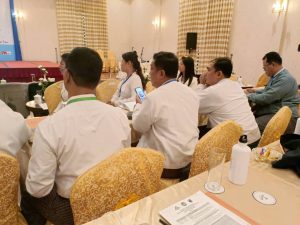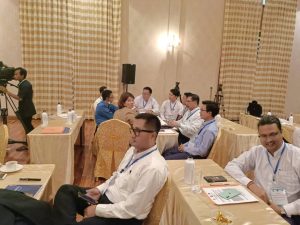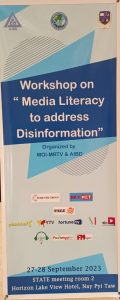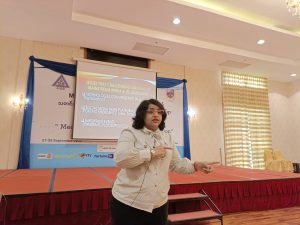
AIBD continues on to Myanmar: Delicate Balance between Disinformation and Truth
Campaign on Transcending Disinformation towards Responsible Media Consumption
By Monica Phang – AIBD Programme Manager
Myanmar Participants in Media Literacy Session
The internet is a massive platform for people to talk and share ideas. But it’s also a place where fake news and wrong information can spread easily. Southeast Asia hasn’t been immune to this either. As more and more people get their information online, it’s really important to be careful and smart about what we believe.
Addressing this pressing concern, Associate Prof. Dr. Sara Chinnasamy, an authority on media studies, emphasized the precarious divide between “Fake” and “Facts” continues AIBD’s efforts in campaigning on Transcending Disinformation towards Responsible Media Consumption during an enlightening session on Day 2 of the Media Literacy to Address Disinformation event, this morning in Nay Pyi Taw, MyanmarDr. Sara Chinnasamy in session in Myanmar today
Dr. Sara highlighted a myriad of challenges that pose a threat to the credibility and objectivity of mainstream media. Among these challenges, she pointed to the convergence of technologies, where artificial intelligence and digitalization have rapidly reshaped the media landscape. In addition, the emergence of social media news platforms has brought about a new metric for success, measured in likes, shares, and views, often eclipsing the importance of responsible journalism.
Crucially, Dr. Sara emphasized the impact of significant news events, such as pandemics, floods, and political upheavals. These events can serve as breeding grounds for misinformation and navigating them requires a steadfast commitment to truth and accuracy.
To remain competitive in this dynamic digital era, mainstream media must adapt to technological convergences. Furthermore, she advocates for the provision of additional “value-added content,” which goes beyond the mere dissemination of news. Independent media outlets have pioneered this approach, incorporating interactive elements such as coffee corners, talk shows, and coverage of non-governmental political issues. These initiatives are designed to cater to the diverse needs and desires of communities, ensuring that media remains an engaged and relevant force in society.
As the digital landscape continues to evolve, Dr. Sara’s insights serve as a timely reminder of the crucial role that responsible journalism plays in upholding the foundations of a healthy democracy. The battle against disinformation begins with a commitment to discerning between the “Fake” and the “Facts,” and it is a battle that requires the concerted efforts of both media professionals and the discerning public.
Dr. Sara Chinnasamy aptly summarizes this challenge:
“There is a thin line between ‘Fake’ and ‘Facts.’ The survival of mainstream media and its objectivity hinges on addressing the convergence of technologies, the emergence of social media news platforms, and the responsible coverage of critical events. By providing value-added content and interactive elements, media outlets can navigate this landscape effectively.”
Related Content: Media Literacy Outreach – The Role of State Media in Nation Building – AIBD






Edited by Dinnierose Raiko – AIBD Programme Manager








